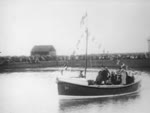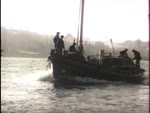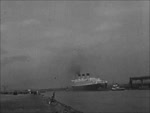GLIMPSE OF THE LIFEBOAT SERVICE, a
Full length video
Please read Understanding catalogue records for help interpreting this information and Using footage for more information about accessing this film.
Title: GLIMPSE OF THE LIFEBOAT SERVICE, a
Reference number: 0641
Date: 1930
Sound: silent
Original format: 35mm
Colour: bw
Fiction: non-fiction
Running time: 9.46 mins
Description: The daily duties of the men working on the lifeboat at Montrose and the hazards they face.
Shotlist: No credits. Title (.06); What the lifeboatmen have to fight. Shots of very heavy seas, waves crashing over a harbour wall and rocks (.53); Montrose, Forfarshire. Two lifeboats are stationed here. One is a motor lifeboat of the Watson Cabin type. 45 ft 6 ins long with an 80 hp engine. The other is a 34 ft surfboat of the self-righting type. Shot of a man running down outside stairs and into a nearby building from which he emerges with a flare which he fires (1.51); Shot of another man working with a basket and rope who runs off camera on seeing the flare (2.00); Crossing the harbour to the lifeboat house. Group of men pull large rowing boat from beach hut, push it into the sea and attach the rudder. They row across the harbour (2.35); On reaching the other side, they run up to the lifeboat house and put on their oilskins and lifejackets (3.07); The motor lifeboat is taken on a trolley to the top of the slipway. A lifeboat, the RNLB "John Russell" emerges on trolley from the boathouse and is pushed to the top of the slipway where it slides down into the sea (4.20); Shot from lifeboat of wake (4.29); The line-throwing gun. Shot of a crew member as he fires the gun (4.38); General shot of those men on board (4.44); Signalling in the morse code with a lamp. Shot of crew man using a lamp to flash morse code (4.56); Shot of bow cutting through water (5.00); Semaphore signalling with flags. Shot of crew man demonstrating semaphore signalling (5.12); The lifeboat is now back at base and is pulled back onto trolley by means of a rope (5.32); The crew, with Coxwain Robert West in front. Shot of crew, numbering about fifteen (5.49); Launching the surfboat by means of a caterpillar tractor. Shot of the surfboat being pulled from a shed on the beach on a large trolley by an old caterpillar tractor (6.23); The crew get in and the Lifeboat is then reversed into the sea still on its trolley and slid off when the water is deep enough (6.52); Shot of boat being rowed out to sea, Viking-ship style, five oarsmen on each side (7.01); Shot of surfboat being replaced on trolley (7.25); You have just seen how the lifeboat service works. Remember that this work is carried on entirely by voluntary contributions. (7.36); The institution requires £3000,000 a year. It is a small sum for such work. It represents only 1 1/2d per head of the population of Great Britain and Ireland. (7.53); Remember also what Sir William Hilary, founder of the institution said - "From the calamity of shipwreck no-one can say that he may at all times remain free and whilst he is now providing only for the safety of others a day may come which will render the cause his own." (8.16). Over 62,000 have been rescued since 1824 (9.46)






